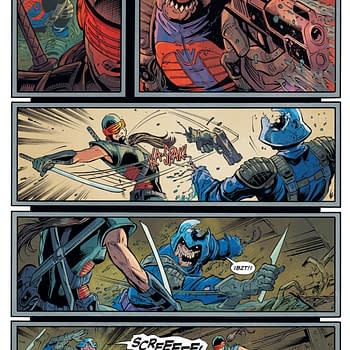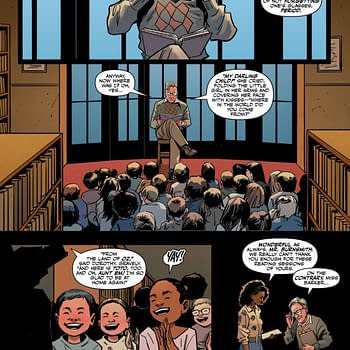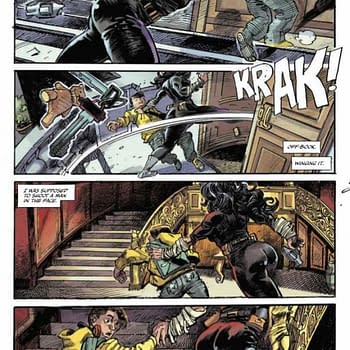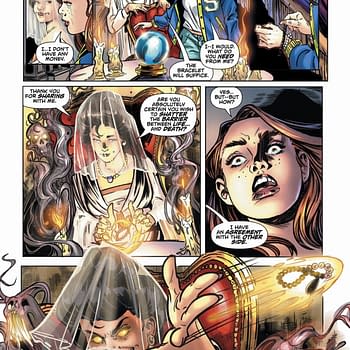Posted in: Comics, Recent Updates | Tagged: Comics, dark horse comics, entertainment, Kelly Fitzpatrick, Neverboy, Peter Panzerfaust, SDCC 2014, shaun simon, The True Lives Of The Fabulous Killjoys, Tyler Jenkins
Dark Horse Reveals Shaun Simon,Tyler Jenkins, Kelly Fitzpatrick On Neverboy For SDCC – Simon And Jenkins Talk Realities Run Wild
Bleeding Cool's SDCC 2014 announcement from Dark Horse is the impending March 2015 series Neverboy written by Shaun Simon of The True Lives of the Fabulous Killjoys and recent Vertigo Quarterly anthologies and drawn by Tyler Jenkins of Peter Panzerfaust and Snow Angel, with colors by Kelly Fitzpatrick of Dark Horse Presents, Peter Panzerfaust, and more.
The series is going to be one of those storylines that sticks in your mind and makes you reevaluate how you view reality and fantasy from what I've learned so far, featuring the collision of lives between the "real world" struggling and self-doubting artist Julian Drag and his once imaginary childhood friend Neverboy.
Dark Horse hints at the coming series thus:
In what world do you belong?
Neverboy, a former imaginary friend, wants the real world. Julian Drag, a struggling artist, wants the imaginary.
When Neverboy's drugs wear off, the surreal hangover he's been running from sets in. And a trip down the rabbit hole is just what Julian has been dying for. When these two meet, the real and imaginary worlds collide in absolute chaos. Neverboy and Julian, the dreamer and the dream, will have to face who they are in order to put things right again.
The plot and themes alone mean that the comic is going to need to play with the division between what's "real" and what's not and Tyler Jenkins' angular, emotive style seems like an excellent match for Shaun Simon's psychologically questioning narrative thread. The story is destined to be "character driven" as Jenkins teases below, in Bleeding Cool's interview with Simon and Jenkins on Neverboy.
Hannah Means-Shannon: My first impression of this story description is that this is some extremely heavy psychological stuff. I recently read a quote that we want "stuff that hasn't happened yet" in our fiction. Is that the kind of "imaginary" that Julian is looking for? What motivates his desire to exist in the imaginary?
Shaun Simon: It's not existing in the imaginary world that Julian Drag wants, it's being able to tap into it and pull stuff out. His is the story of a creator losing his inspiration. He's an artist who's first work opened to critical acclaim and has never been able to get the right colors on the canvas for his second. Now, whether this is just a case of not being able to live up to his first work or that he has, in fact, lost the ability that all creators hold so dear, to dive into the imaginary world for the sake of their art, is to be seen.
HMS: How do you go about rendering an "imaginary" character like Neverboy real to the reader? What sort of rules of existence does he abide by that are similar or different to our own?
SS: Neverboy may be imaginary but his plight is very real. The stories I love and that resonate the most with me are ones that give very real problems to very strange characters in strange worlds. Neverboy has been breaking the rules for a long time by using drugs to keep him in the real world and giving him the life he's dreamed of. But when those drugs wear off and reality sets in, the life he's created for himself begins to crumble.
HMS: Is it the natural result of things that when the "real" and "imaginary" overstep their boundaries, chaos ensues? What kind of chaos are we talking about here? Personal? Global?
SS: The story deals with abusing creativity for personal gain. It is very character driven and while Neverboy and Julian are the focus, the ramifications of their actions bleed over into the world at large.
HMS: Gerard Way attributed the removal of masks in Killjoys to you in an interview where I talked with him. It seems like breaking down barriers in this comic might strike a related chord. When we divide our "real" and "imaginary" worlds, does that limit us? Is there a way for the two to interact in a less divisive way?
SS: The two interact all the time but there is a balance and clear division between them. When the weight on one side of that balance becomes heavier, the division becomes less clear. Some of the themes in Killjoys are themes that will probably be a constant in my writing.
HMS: The grass is always greener on the other side. What are the things about Julian's world that Neverboy isn't prepared for, and what are the things about Neverboy's reality that Julian may be wearing rose-tinted glasses about?
SS: Neverboy and Julian both want what they can't have and sometimes when you get what you want it isn't always what you imagined it to be.
HMS: Tyler, Can you tell us a little bit about designing our two main characters, Julian and Neverboy, and how you made choices about conveying their personalities in their appearance and body language?
Tyler Jenkins: To answer this question it is, maybe, first, important to define to a minor degree their personalities. Or at least the aspects of which I designed to. Neverboy is honest and naive. In my mind, he is not really lying to himself but has fully given himself to the fantasies he has created. He, due to aspects of his creation, is quite immature, and extravagant without being aware of it. Therefore he comes by his appearance as a natural and unconsciously created reflection of his true self. There is no pretense. He can be wonderfully, childishly extravagant and messy, and hip. Hence the black leather jackets, wild hair, cool t shirts…all a reflection of his enthusiastic hopefulness. Julian, on the other hand, is almost exactly opposite in his personality, and his appearance is the shabby remnants of a life lived full of pretentious posturing…more interested, in the end with looking the part of the artist than actually being the artist. A nihilistic, and in the end, despairing view.
HMS: What have you found to be the most appealing challenge for visually presenting this tale of differing realities so far? What about this story made you want to get onboard and make it your project, too?
TJ: That which I saw to be the challenge was also what interested me most about this story. That is the characters. The creation of a world is, of course, interesting, and the addition of parallel realities makes it more so, but it is the characters' stories, their development, their journey…to create an honest portrayal of these characters' emotional lives is what I find the best and most interesting part of any story. Without the genuine interest in the characters, and in how to portray them, I would have simply not worked on this project.
HMS: Since Julian is an artist, do you find any points of identification there? Do you find your experience of the dichotomy between reality and the imaginative world to be similar or different?
TJ: I think the basic struggle for creative happiness is there, but, in truth, without giving away the story, I cannot fully answer why I don't identify with Julian as an artist, per se.
My experience is totally different. The work I do is completely narrative, and my inspiration comes from the stories I am telling. If the story is no good, my interest wanes. If the story is compelling, I will be inspired. As far as the imaginative and real world go, to me they are one in the same. I tell stories, or bring to stories I am working on, parts of my real life. The world or the fantasy is only trappings to clothe the truth of the narrative.
HMS: I feel a little cheeky having asked these creators such probing questions about a comic where they can only reveal so much at this stage, but they were good sports and certainly elucidated plenty of the big picture within the story and also just what makes this project meaningful for them personally. This is just the kind of comic, in fact, that I find particularly compelling, defying any specific genre expectations in the pursuit of narratives that simply speak to the reader about their own lives and aspirations.
Those kinds of stories can only really be told with a great deal of imagination, so what better theme for the book than the imagination itself? Looking forward to March 2015, and thanks to Shaun and Tyler for taking the time to answer our questions about their big announcement.
















